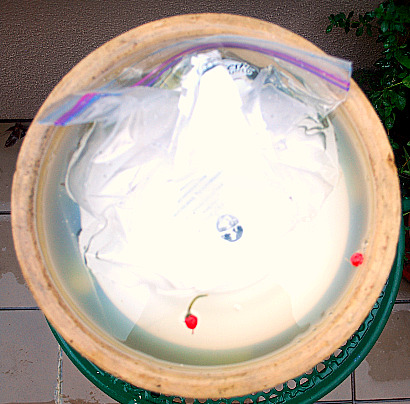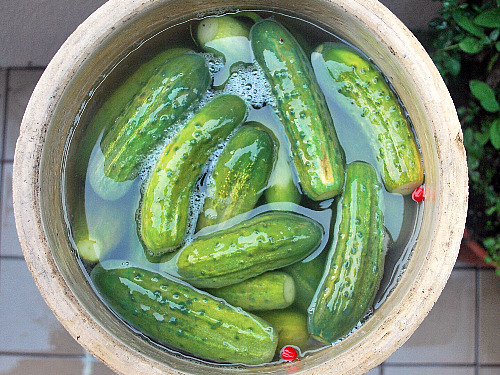More like 4 types of pickles completed in 3 days, and 3 more types of pickles in various stages of brining, pickling or curing as I type this.
I bought ~ 100 pounds (of assorted sizes) of fresh-picked pickling cucumbers on Friday, and the first thing I did when I got them home was put them in big tubs of fresh cold water. Letting them sit overnight in water makes it easier to scrub the little bits of dust and dirt from their nubby skins the next morning and enhances their crispiness later.
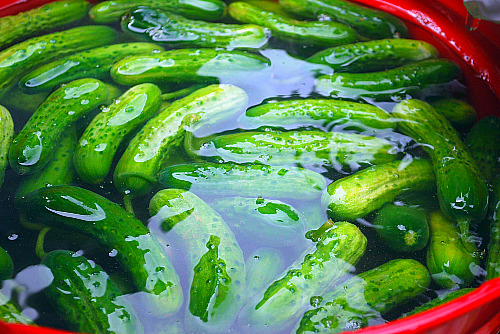 Pickling cukes soaking in a tub of clean cold water overnight.
Pickling cukes soaking in a tub of clean cold water overnight.
The smallest cukes, which were between 1 and 2 inches long, were made into Cornichons. A tangy little French pickle, perfect for serving with pate`s and cheeses, and like miniature corn, extra fun to eat because of their cuteness factor.
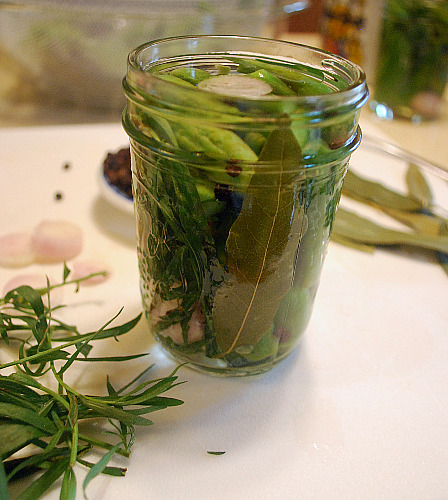 Cornichons, which are flavored with bay leaf, fresh tarragon, shallots, and peppercorns. White white wine vinegar is added to the brine.
Cornichons, which are flavored with bay leaf, fresh tarragon, shallots, and peppercorns. White white wine vinegar is added to the brine.
The next size up, the 2 inch ~ 3 inch cukes, are still processing. I think they are just the right size for Sweet Gherkins.
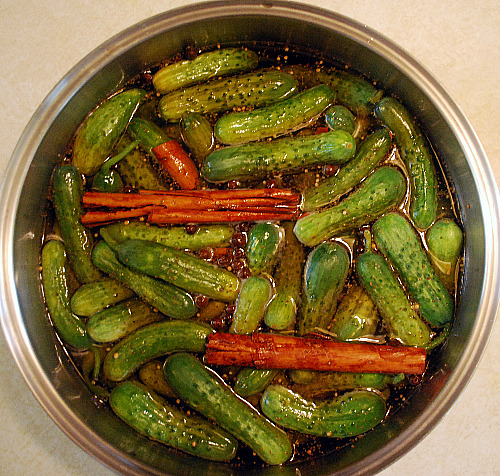 Sweet Gherkins cooking in a brine of apple cider vinegar and spices.
Sweet Gherkins cooking in a brine of apple cider vinegar and spices.
The 3 inch cukes are at their halfway point of a recipe called
"9 Day Pickles":
 9 Day Pickles in brine, on Day One
9 Day Pickles in brine, on Day One
I'll update you on these...they're resting!
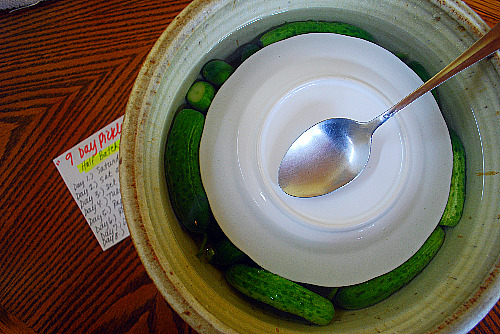
9 Day Pickles, being kept submerged in brine with a plate.
The most common pickling cukes seem to be about 4 inches long, and I find these are the perfect length for my Blue Ribbon Dills. I added different types of peppers to this batch. I mostly used Red Fresno peppers.
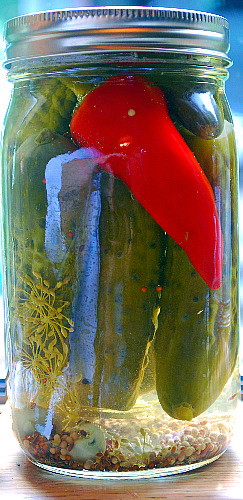 Brilliant red Fresno pepper in with my Blue Ribbon Dills.
Brilliant red Fresno pepper in with my Blue Ribbon Dills.
In one -- and only one jar -- I added Habanero peppers, for my almost husband, who hails from Texas. And a new addition to my pickle recipes this year is an itty bitty pepper called Apache. I bought the dwarf Apache Pepper plants because I thought their diminutive size would make them a nice addition to flower pots on my balcony, and I discovered that the tiny round peppers that grew on the plants were just adorable! (You can see them scattered across the tops of the Deli-style Spears, pictured below.)
I had quite a few cukes that were too big for Blue Ribbon Dills, so we cut those up into wedges, for Deli-style Dill Spears. At that point, I had a few helpers, and packing the jars went really quick! 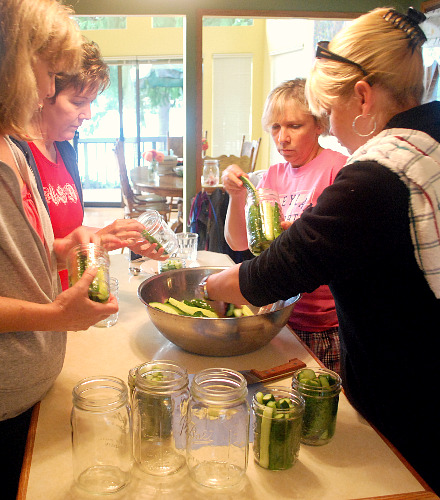
The best part? They worked in exchange for pickles!
In addition to packing the wedges, or "Spears" into jars, we took turns adding dill seed, flowering dill heads, garlic, and dwarf Apache peppers to the jars....beautiful!
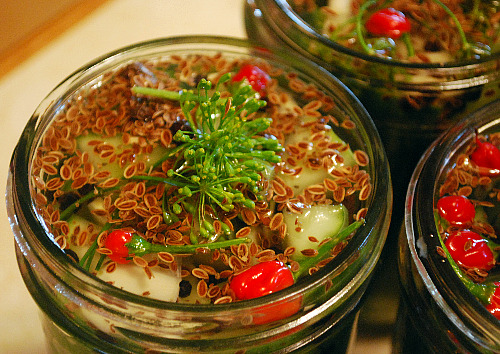 Herbs, spices and brine are added after packing the Deli-style Spears tightly into the jars.
Herbs, spices and brine are added after packing the Deli-style Spears tightly into the jars.
The Deli-Style Dill Spears turned out great. What a team!
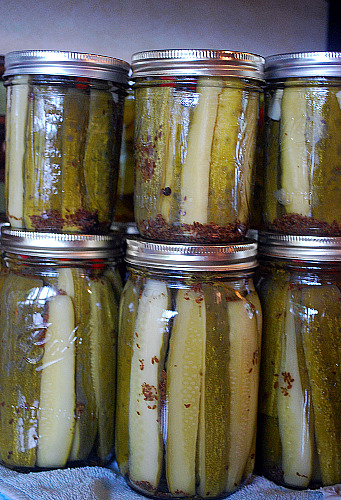 Deli-style Dill Spears, cooling off after processing.
Deli-style Dill Spears, cooling off after processing.
I realized we still had another big tub full of what the cucumber farm called "Large" and "Extra Large". They weren't so big that I wanted to use them for the wedge cuts, but I felt they were a bit over-sized for my Blue Ribbon Dills.
The solution? Slice up the odd-sized cucumbers and used them up and make Classic Bread & Butter Pickle Slices!
I still had my helpers, so one of us sliced up onions, the other bell peppers, and another person was on garlic peeling/chopping duty. We decided to stop when my big stainless steel bowl was full of a mixture of sliced cukes, onions, peppers, and onions. The results:
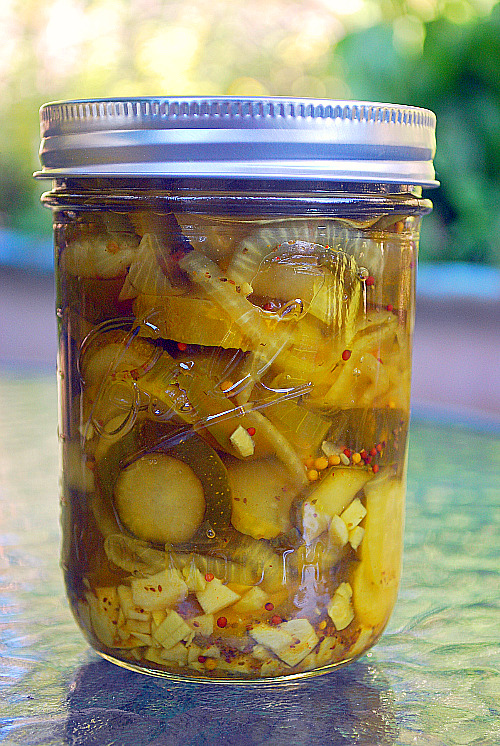 Classic Bread & Butter Pickles
Classic Bread & Butter Pickles
At that point, I had about 5 pounds of pickling cukes left, and I decided those would be my NYC-style Sour Dill Pickles.
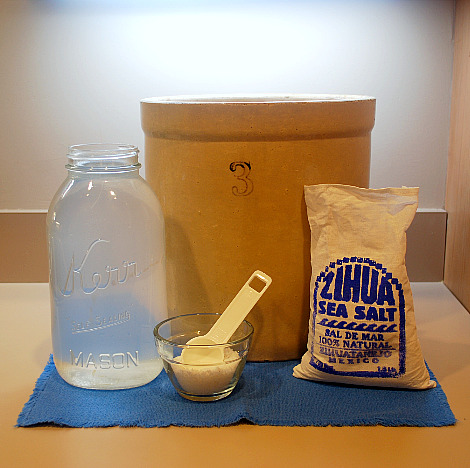 I used sea salt for the brine.
I used sea salt for the brine.
Added garlic cloves, flowering dill, and peppers:
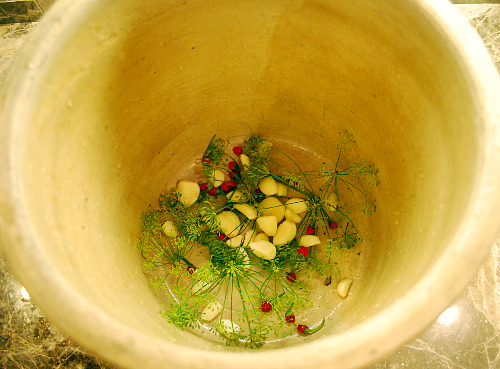 A view inside the 3 gallon crock
A view inside the 3 gallon crock
A layer of just-picked grape leaves:
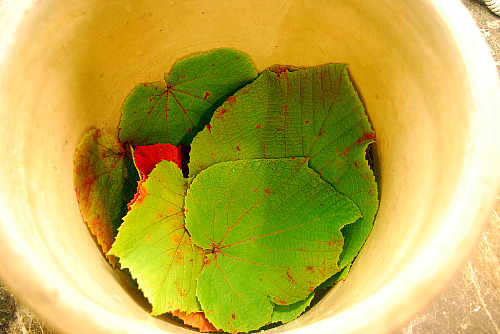
Grape leaves line the bottom of the crock.
Add 5 pounds of scrubbed trimmed cukes:
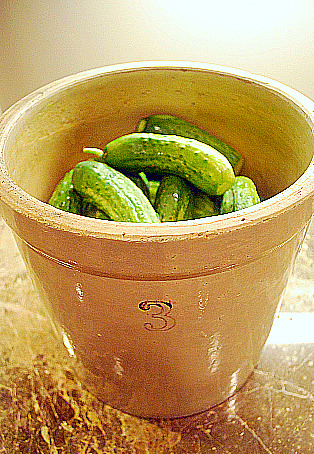
5 pounds of cukes in a 3 gallon crock
Then I added brine, and weighted down the cucumbers with a plate, in order to keep them covered with brine. Depending on the weather, and a few other factors, plus a small amount of daily TLC, in about 1 to 4 weeks, these should turn into the most super delicious garlick-y, dilly Seattle-made New York City-style Sour Dill Pickles you've ever had!
This is the only fermented pickle I am doing right now, but I plan to do more soon. After all, I still have several crocks, just waiting to be filled.
 Brook Hurst Stephens
Brook Hurst Stephens
